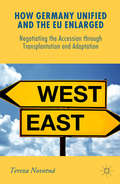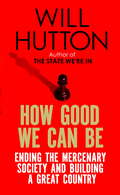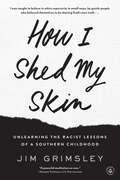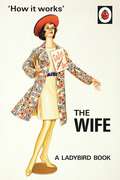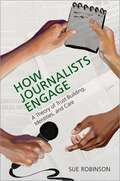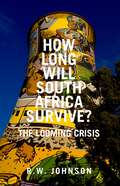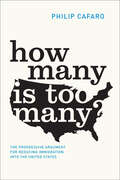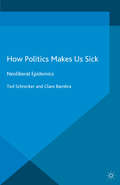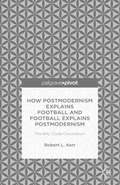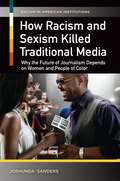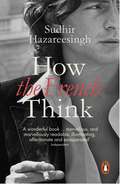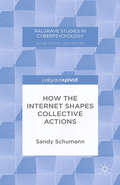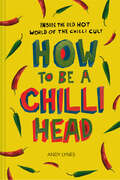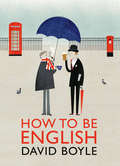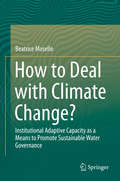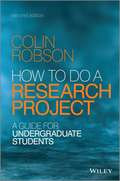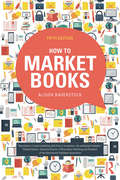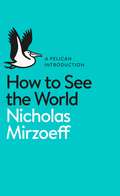- Table View
- List View
How Germany Unified and the EU Enlarged: Negotiating the Accession through Transplantation and Adaptation (New Perspectives in German Political Studies)
by Tereza NovotnáBased on original empirical research that includes 90 interviews with key leaders, this book compares and contrasts negotiations during the processes of German unification and Eastern enlargement of the EU, with particular attention to the Czech Republic. It develops two models of political integration and suggests that such integration can take place by means of a take-over (Transplantation), or by the joining entity adjusting to the norms and institutions of the accepting party (Adaptation). In addition to an exploration of these two different models and a detailed examination of the two cases, the book points to other historical examples of Transplantation and Adaptation and formulates lessons for where future research might travel, temporarily and geographically, in the cases of other political integrations. Providing new insights into German unification and European integration, this text is key reading for academics, advanced undergraduate and graduate students in EU Politics, as well as policy-makers and the wider public.
How Good We Can Be: Ending the Mercenary Society and Building a Great Country
by Will HuttonBritain is beset by a crisis of purpose. For a generation we have been told the route to universal well-being is to abandon the expense of justice and equity and so allow the judgments of the market to go unobstructed. What has been created is not an innovative, productive economy but instead a capitalism that extracts value rather than creates it, massive inequality, shrinking opportunity and a society organised to benefit the top 1%. The capacity to create new jobs and start-ups should not disguise that in the main the new world is one of throw away people working in throw away companies. The British are at a loss. The warnings of The State We're In have been amply justified. Will Hutton observes that the trends that so disturbed him twenty years ago have become more marked. Rather than take refuge in nativism and virulent euro-scepticism, Britain must recognize that its problems are largely made at home - and act to change them. With technological possibilities multiplying, a wholesale makeover of the state, business and the financial system is needed to seize the opportunities by being both fairer and more innovative. The aim must be to create an economy, society and democracy in which the mass of citizens flourish. In this compelling and vital new book Hutton spells out how.
How I Shed My Skin: Unlearning the Racist Lessons of a Southern Childhood
by Jim GrimsleyCritically acclaimed novelist Jim Grimsley looks back at the federally mandated racial integration of his school in 1966, remembering his own first real encounters with black children and their culture. The result is a true and moving personal narrative of race relations.
How it Works: The Wife (Ladybirds for Grown-Ups #2)
by Joel Morris Jason HazeleyThe PERFECT GIFT for your long-suffering wife or prospective bride. Or, for any fool of a husband or seriously deluded groom-to-be who hasn't yet understood what he's signed up for.--------------------Tina is getting married. It is the best day of her life.Next year, she will claim that becoming a mother was the best day of her life, but only because she was on some very strong drugs.Neither is true. The best day of her life was on her eighth birthday, when she got a yellow bike. --------------------The wife likes surprises.Her favourite sort is a surprise birthday party.It is the husband's job to organise this surprise for her, and to keep her informed of every detail about it.--------------------This delightful book is the latest in the series of Ladybird books which have been specially planned to help grown-ups with the world about them. The large clear script, the careful choice of words, the frequent repetition and the thoughtful matching of text with pictures all enable grown-ups to think they have taught themselves to cope. Featuring original Ladybird artwork alongside brilliantly funny, brand new text. 'Hilarious' Stylist
How Journalists Engage: A Theory of Trust Building, Identities, and Care
by Sue RobinsonA unique theory of trust building in engagement journalism that proposes journalists move to an ethic of care as they prioritize listening and learning within communities instead of propping up problematic institutions. In How Journalists Engage, Sue Robinson explores how journalists of different identities, especially racial, enact trusting relationships with their audiences. Drawing from case studies, community-work, interviews, and focus groups, she documents a growing built environment around trust building and engagement journalism that represents the first major paradigm shift of the press's core values in more than a century. As Robinson shows, journalists are being trained to take on new roles and skillsets around listening and learning, in addition to normative routines related to being a watchdog and storyteller. She demonstrates how this movement mobilizes the nurturing of personal, organizational, and institutional relationships that people have with information, sources, news brands, journalists, and each other. Developing a new theory of trust building, Robinson calls for journalists to grapple actively with their own identities--especially the privileges, biases, and marginalization attached to them--and those of their communities, resulting in a more intentional and effective moral voice focused on justice and equity through the news practice of an ethic of care.
How Long Will South Africa Survive?: The Looming Crisis
by R.W. JohnsonIn 1977, Johnson's best selling How Long Will South Africa Survive? offered a controversial and highly original analysis of the survival prospects of apartheid. Now, after more than two decades of the ANC in government, he believes the question must be posed again. "The big question about ANC rule," Johnson writes, "is whether African nationalism would be able to cope with the challenges of running a modern industrial economy. Twenty years of ANC rule have shown conclusively that the party is hopelessly ill equipped for this task. Indeed, everything suggests that South Africa under the ANC is fast slipping backward and that even the survival of South Africa as a unitary state cannot be taken for granted. The fundamental reason why the question of regime change has to be posed is that it is now clear that South Africa can either choose to have an ANC government or it can have a modern industrial economy. It cannot have both."
How Many Is Too Many?: The Progressive Argument for Reducing Immigration into the United States (Chicago Studies in American Politics)
by Philip CafaroFrom the stony streets of Boston to the rail lines of California, from General Relativity to Google, one of the surest truths of our history is the fact that America has been built by immigrants. The phrase itself has become a steadfast campaign line, a motto of optimism and good will, and indeed it is the rallying cry for progressives today who fight against tightening our borders. This is all well and good, Philip Cafaro thinks, for the America of the past—teeming with resources, opportunities, and wide open spaces—but America isn’t as young as it used to be, and the fact of the matter is we can’t afford to take in millions of people anymore. We’ve all heard this argument before, and one might think Cafaro is toeing the conservative line, but here’s the thing: he’s not conservative, not by a long shot. He’s as progressive as they come, and it’s progressives at whom he aims with this book’s startling message: massive immigration simply isn’t consistent with progressive ideals. Cafaro roots his argument in human rights, equality, economic security, and environmental sustainability—hallmark progressive values. He shows us the undeniable realities of mass migration to which we have turned a blind eye: how flooded labor markets in sectors such as meatpacking and construction have driven down workers’ wages and driven up inequality; how excessive immigration has fostered unsafe working conditions and political disempowerment; how it has stalled our economic maturity by keeping us ever-focused on increasing consumption and growth; and how it has caused our cities and suburbs to sprawl far and wide, destroying natural habitats, driving other species from the landscape, and cutting us off from nature. In response to these hard-hitting truths, Cafaro lays out a comprehensive plan for immigration reform that is squarely in line with progressive political goals. He suggests that we shift enforcement efforts away from border control and toward the employers who knowingly hire illegal workers. He proposes aid and foreign policies that will help people create better lives where they are. And indeed he supports amnesty for those who have, at tremendous risk, already built their lives here. Above all, Cafaro attacks our obsession with endless material growth, offering in its place a mature vision of America, not brimming but balanced, where all the different people who constitute this great nation of immigrants can live sustainably and well, sheltered by a prudence currently in short supply in American politics.
How Many Is Too Many?: The Progressive Argument for Reducing Immigration into the United States (Chicago Studies in American Politics)
by Philip CafaroFrom the stony streets of Boston to the rail lines of California, from General Relativity to Google, one of the surest truths of our history is the fact that America has been built by immigrants. The phrase itself has become a steadfast campaign line, a motto of optimism and good will, and indeed it is the rallying cry for progressives today who fight against tightening our borders. This is all well and good, Philip Cafaro thinks, for the America of the past—teeming with resources, opportunities, and wide open spaces—but America isn’t as young as it used to be, and the fact of the matter is we can’t afford to take in millions of people anymore. We’ve all heard this argument before, and one might think Cafaro is toeing the conservative line, but here’s the thing: he’s not conservative, not by a long shot. He’s as progressive as they come, and it’s progressives at whom he aims with this book’s startling message: massive immigration simply isn’t consistent with progressive ideals. Cafaro roots his argument in human rights, equality, economic security, and environmental sustainability—hallmark progressive values. He shows us the undeniable realities of mass migration to which we have turned a blind eye: how flooded labor markets in sectors such as meatpacking and construction have driven down workers’ wages and driven up inequality; how excessive immigration has fostered unsafe working conditions and political disempowerment; how it has stalled our economic maturity by keeping us ever-focused on increasing consumption and growth; and how it has caused our cities and suburbs to sprawl far and wide, destroying natural habitats, driving other species from the landscape, and cutting us off from nature. In response to these hard-hitting truths, Cafaro lays out a comprehensive plan for immigration reform that is squarely in line with progressive political goals. He suggests that we shift enforcement efforts away from border control and toward the employers who knowingly hire illegal workers. He proposes aid and foreign policies that will help people create better lives where they are. And indeed he supports amnesty for those who have, at tremendous risk, already built their lives here. Above all, Cafaro attacks our obsession with endless material growth, offering in its place a mature vision of America, not brimming but balanced, where all the different people who constitute this great nation of immigrants can live sustainably and well, sheltered by a prudence currently in short supply in American politics.
How Many Is Too Many?: The Progressive Argument for Reducing Immigration into the United States (Chicago Studies in American Politics)
by Philip CafaroFrom the stony streets of Boston to the rail lines of California, from General Relativity to Google, one of the surest truths of our history is the fact that America has been built by immigrants. The phrase itself has become a steadfast campaign line, a motto of optimism and good will, and indeed it is the rallying cry for progressives today who fight against tightening our borders. This is all well and good, Philip Cafaro thinks, for the America of the past—teeming with resources, opportunities, and wide open spaces—but America isn’t as young as it used to be, and the fact of the matter is we can’t afford to take in millions of people anymore. We’ve all heard this argument before, and one might think Cafaro is toeing the conservative line, but here’s the thing: he’s not conservative, not by a long shot. He’s as progressive as they come, and it’s progressives at whom he aims with this book’s startling message: massive immigration simply isn’t consistent with progressive ideals. Cafaro roots his argument in human rights, equality, economic security, and environmental sustainability—hallmark progressive values. He shows us the undeniable realities of mass migration to which we have turned a blind eye: how flooded labor markets in sectors such as meatpacking and construction have driven down workers’ wages and driven up inequality; how excessive immigration has fostered unsafe working conditions and political disempowerment; how it has stalled our economic maturity by keeping us ever-focused on increasing consumption and growth; and how it has caused our cities and suburbs to sprawl far and wide, destroying natural habitats, driving other species from the landscape, and cutting us off from nature. In response to these hard-hitting truths, Cafaro lays out a comprehensive plan for immigration reform that is squarely in line with progressive political goals. He suggests that we shift enforcement efforts away from border control and toward the employers who knowingly hire illegal workers. He proposes aid and foreign policies that will help people create better lives where they are. And indeed he supports amnesty for those who have, at tremendous risk, already built their lives here. Above all, Cafaro attacks our obsession with endless material growth, offering in its place a mature vision of America, not brimming but balanced, where all the different people who constitute this great nation of immigrants can live sustainably and well, sheltered by a prudence currently in short supply in American politics.
How Many Is Too Many?: The Progressive Argument for Reducing Immigration into the United States (Chicago Studies in American Politics)
by Philip CafaroFrom the stony streets of Boston to the rail lines of California, from General Relativity to Google, one of the surest truths of our history is the fact that America has been built by immigrants. The phrase itself has become a steadfast campaign line, a motto of optimism and good will, and indeed it is the rallying cry for progressives today who fight against tightening our borders. This is all well and good, Philip Cafaro thinks, for the America of the past—teeming with resources, opportunities, and wide open spaces—but America isn’t as young as it used to be, and the fact of the matter is we can’t afford to take in millions of people anymore. We’ve all heard this argument before, and one might think Cafaro is toeing the conservative line, but here’s the thing: he’s not conservative, not by a long shot. He’s as progressive as they come, and it’s progressives at whom he aims with this book’s startling message: massive immigration simply isn’t consistent with progressive ideals. Cafaro roots his argument in human rights, equality, economic security, and environmental sustainability—hallmark progressive values. He shows us the undeniable realities of mass migration to which we have turned a blind eye: how flooded labor markets in sectors such as meatpacking and construction have driven down workers’ wages and driven up inequality; how excessive immigration has fostered unsafe working conditions and political disempowerment; how it has stalled our economic maturity by keeping us ever-focused on increasing consumption and growth; and how it has caused our cities and suburbs to sprawl far and wide, destroying natural habitats, driving other species from the landscape, and cutting us off from nature. In response to these hard-hitting truths, Cafaro lays out a comprehensive plan for immigration reform that is squarely in line with progressive political goals. He suggests that we shift enforcement efforts away from border control and toward the employers who knowingly hire illegal workers. He proposes aid and foreign policies that will help people create better lives where they are. And indeed he supports amnesty for those who have, at tremendous risk, already built their lives here. Above all, Cafaro attacks our obsession with endless material growth, offering in its place a mature vision of America, not brimming but balanced, where all the different people who constitute this great nation of immigrants can live sustainably and well, sheltered by a prudence currently in short supply in American politics.
How Politics Makes Us Sick: Neoliberal Epidemics
by T. Schrecker C. BambraTed Schrecker and Clare Bambra argue that the obesity, insecurity, austerity and inequality that result from neoliberal (or 'market fundamentalist') policies are hazardous to our health, asserting that these neoliberal epidemics require a political cure.
How Postmodernism Explains Football and Football Explains Postmodernism: The Billy Clyde Conundrum
by Robert KerrAmerican football and postmodernist theory are both objects of popular and scholarly interest that reveal remarkable sociological insights. Analysis of media-driven commercial football documents how narratives of sportsmanship/brutality, heroism/antiheroism, athleticism/self-indulgence, honor/chicanery, and chivalry/sexism compete and thrive.
How Racism and Sexism Killed Traditional Media: Why the Future of Journalism Depends on Women and People of Color (Racism in American Institutions)
by Joshunda SandersAn evaluative examination that challenges the media to rise above the systematic racism and sexism that persists across all channels, despite efforts to integrate.The Internet and social networks have opened up new avenues of communication for women and people of color, but the mainstream news is still not adequately including minority communities in the conversation. Part of the Racism in America series, How Racism and Sexism Killed the Traditional Media: Why the Future of Journalism Depends on Women and People of Color reveals the lack of diversity that persists in the communication industry. Uncovering and analyzing the racial bias in the media and in many newsrooms, this book reveals the lesser-known side of the media—newsrooms and outlets that are often fraught with underlying racist and sexist tension.Written by a veteran journalist of color, this title brings an insider's perspective combined with interviews from industry experts. The book analyzes the traditional media's efforts to integrate both women and people of color into legacy newsrooms, highlighting their defeats and minor successes. The author examines the future of women and people of color in the mainstream media.
How Racism and Sexism Killed Traditional Media: Why the Future of Journalism Depends on Women and People of Color (Racism in American Institutions)
by Joshunda SandersAn evaluative examination that challenges the media to rise above the systematic racism and sexism that persists across all channels, despite efforts to integrate.The Internet and social networks have opened up new avenues of communication for women and people of color, but the mainstream news is still not adequately including minority communities in the conversation. Part of the Racism in America series, How Racism and Sexism Killed the Traditional Media: Why the Future of Journalism Depends on Women and People of Color reveals the lack of diversity that persists in the communication industry. Uncovering and analyzing the racial bias in the media and in many newsrooms, this book reveals the lesser-known side of the media—newsrooms and outlets that are often fraught with underlying racist and sexist tension.Written by a veteran journalist of color, this title brings an insider's perspective combined with interviews from industry experts. The book analyzes the traditional media's efforts to integrate both women and people of color into legacy newsrooms, highlighting their defeats and minor successes. The author examines the future of women and people of color in the mainstream media.
How the French Think: An Affectionate Portrait of an Intellectual People
by Sudhir HazareesinghSudhir Hazareesingh's How the French Think is a warm yet incisive exploration of the French intellectual tradition, and its exceptional place in a nation's identity and lifestyleWhy are the French an exceptional nation? Why do they think they are so exceptional? An important reason is that in France intellectual activity is regarded not just as the preserve of the thinking elite but for almost everyone. French thought can sometimes be austere and often opaque, yet it is undeniably bold and innovative, and driven by a relentless quest for the regeneration of humanity. Sudhir Hazareesingh traces its tumultuous history in an enormously enjoyable and highly original manner, showing how the French ways of thought and life connect. This will be one of the most revealing books written about them - or any other European country - for years.Sudhir Hazareesingh was born in Mauritius. He is a Fellow of the British Academy and has been a Fellow and Tutor in Politics at Balliol College, Oxford, since 1990. Among his books are The Legend of Napoleon (Granta, 2004) and Le MytheGaullien (Gallimard, 2010). He won the Prix du Memorial d'Ajaccio and the Prix de la Fondation Napoleon for the first of these, and a Prix d'Histoire du Senat for the second.
How the Internet Shapes Collective Actions (Palgrave Studies in Cyberpsychology)
by S. SchumannAfter a Facebook rebellion in Egypt and Twitter protests in Turkey, the internet has been proclaimed as a globe-shifting, revolutionizing force that can incite complex social phenomena such as collective actions. This book critically assesses this claim and highlights how internet use can shape mobilizing processes to foster collective actions.
How to Be A Chilli Head
by Andy LynesWelcome to the world of the chilli cult. All over the globe, people are getting together to grow chilli, taste chilli and make sauce hot enough to blow their heads off. Competition among chilli -growers is fierce, and tall tales of dastardly deeds abound. This sizzling-hot book is your essential guide to the chilli world, with inside information on where to find the tastiest varieties, where to eat the best chilli -packed street food, and the race to produce the hottest chilli ever known. Find out the secrets of chilli science – why a slug of water won't help when your mouth's on fire, what effect eating a super-hot chilli has on your body, and how do you measure how hot a chilli is? If you want to grow your own chilli, this book contains a wealth of foolproof cultivation tips, and, of course, there's a delicious selection of chilli recipes to make with your first harvest. Packed with features, facts and fun,How to Be a ChilliHeadis the perfect gift for the chilli obsessive in your life. Word count: 20,000
How to Be English
by David BoyleEnglish culture is confused, muddled and often borrowed. The purpose of this book is to give the reader a complete grounding in the idiosyncrasies of the English and to pin down the absurdities and warmth of Englishness at its best.Featured in this book are such established English cultural behemoths as the Beatles, Big Ben and the Last Night of the Proms alongside less celebrated quirks such as meat pies and the working man’s haven, the allotment. Here we celebrate the bell-ringers and Morris dancers, bowler hats (‘the symbol of respectable Englishness’) and cardigans (‘symbol of staid middle-class solidarity’). We examine the brutality of Punch and Judy and our historic love of fairies, once so much a part of the English psyche that they were described as ‘the British religion’.At once fond and irreverent, laudatory and curious, How to Be English might just teach us how to be English once again.
How to Deal with Climate Change?: Institutional Adaptive Capacity as a Means to Promote Sustainable Water Governance
by Beatrice MoselloAs the evidence for human-induced climate change becomes more obvious, so too does the realisation that it will harshly impact on the natural environment as well as on socio-economic systems. Addressing the unpredictability of multiple sources of global change makes the capacity of governance systems to deal with uncertainty and surprise essential. However, how all these complex processes act in concert and under which conditions they lead to the sustainable governance of environmental resources are questions that have remained relatively unanswered. This book aims at addressing this fundamental gap, using as case examples the basins of the Po River in Northern Italy and the Syr Darya River in Kyrgyzstan. The opening chapter addresses the challenges of governing water in times of climate and other changes. Chapter Two reviews water governance through history and science. The third chapter outlines a conceptual framework for studying institutional adaptive capacity. The next two chapters offer detailed case studies of the Po and Syr Darya rivers, followed by a chapter-length analysis and comparison of adaptive water resources management in the two regions. The discussion includes a description of resistant, reactive and proactive institutions and puts forward ideas on how water governance regimes can transition from resistant to proactive. The final chapter takes a high-level view of lessons learned and how to transform these into policy recommendations and offers a perspective on embracing uncertainty and meeting future challenges.
How To Do A Research Project 2E - A Guide For Undergraduate Students
by Colin RobsonWritten specifically to address the needs and concerns of the undergraduate, this tightly focused second edition guides students through the process of conducting and completing a research project. Friendly and accessible, this fully-updated second edition includes a number of accompanying student support materials to aid students further. Closely integrated sets of end-of-chapter tasks covering all aspects of research projects from design to completion, as well as suggested further reading, enhance each chapter. A wide range of additional helpful materials relevant to particular subject areas is also available on the accompanying website at www. wiley. com/college/robson. This textbook is an invaluable resource for students in a wide range of disciplines and fields of study, particularly those planning to use social research methods or to carry out a library-based study, for their undergraduate research project.
How to Do Things with Pornography
by Nancy BauerIn Nancy Bauer’s view, most feminist philosophers are content to work within theoretical frameworks that are false to human beings’ everyday experiences. Here she models a new way to write about pornography, women’s self-objectification, hook-up culture, and other contemporary phenomena, and in doing so she raises basic questions about philosophy.
How to Do Things with Pornography
by Nancy BauerIn Nancy Bauer’s view, most feminist philosophers are content to work within theoretical frameworks that are false to human beings’ everyday experiences. Here she models a new way to write about pornography, women’s self-objectification, hook-up culture, and other contemporary phenomena, and in doing so she raises basic questions about philosophy.
How to Market Books
by Alison Baverstock'Baverstock is to book marketing what Gray is to anatomy; the undisputed champion.' Richard Charkin, Executive Director of Bloomsbury Publishing and President Elect of the International Publishers Association Over four editions, Alison Baverstock’s How to Market Books has established itself as the industry standard text on marketing for the publishing industry, and the go-to reference guide for professionals and students alike. With the publishing world changing like never before, and the marketing and selling of content venturing into uncharted technological territory, this much needed new edition seeks to highlight the role of the marketer in this rapidly changing landscape. The new edition is thoroughly updated and offers a radical reworking and reorganisation of the previous edition, suffusing the book with references to online/digital marketing. The book maintains the accessible and supportive style of previous editions but also now offers: a number of new case studies detailed coverage of individual market segments checklists and summaries of key points several new chapters a foreword by Michael J Baker, Professor Emeritus of Marketing, Strathclyde University.
How to Market Books
by Alison Baverstock'Baverstock is to book marketing what Gray is to anatomy; the undisputed champion.' Richard Charkin, Executive Director of Bloomsbury Publishing and President Elect of the International Publishers Association Over four editions, Alison Baverstock’s How to Market Books has established itself as the industry standard text on marketing for the publishing industry, and the go-to reference guide for professionals and students alike. With the publishing world changing like never before, and the marketing and selling of content venturing into uncharted technological territory, this much needed new edition seeks to highlight the role of the marketer in this rapidly changing landscape. The new edition is thoroughly updated and offers a radical reworking and reorganisation of the previous edition, suffusing the book with references to online/digital marketing. The book maintains the accessible and supportive style of previous editions but also now offers: a number of new case studies detailed coverage of individual market segments checklists and summaries of key points several new chapters a foreword by Michael J Baker, Professor Emeritus of Marketing, Strathclyde University.
How to See the World
by Nicholas MirzoeffIn recent decades, we have witnessed an explosion in the number of visual images we encounter, as our lives have become increasingly saturated with screens. From Google Images to Instagram, video games to installation art, this transformation is confusing, liberating and worrying all at once, since observing the new visuality of culture is not the same as understanding it. Nicholas Mirzoeff is a leading figure in the field of visual culture, which aims to make sense of this extraordinary explosion of visual experiences. As Mirzoeff reminds us, this is not the first visual revolution; the 19th century saw the invention of film, photography and x-rays, and the development of maps, microscopes and telescopes made the 17th century an era of visual discovery. But the sheer quantity of images produced on the internet today has no parallels. In the first book to define visual culture for the general reader, Mirzoeff draws on art history, theory and everyday experience to provide an engaging and accessible overview of how visual materials shape and define our lives.
